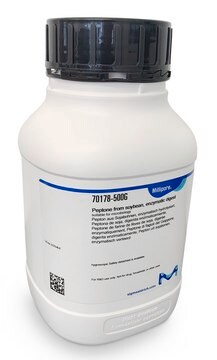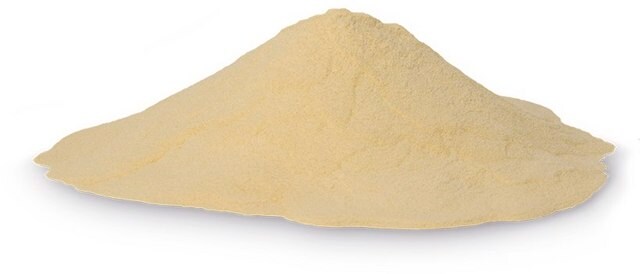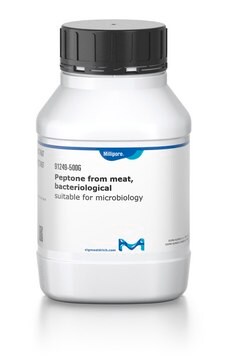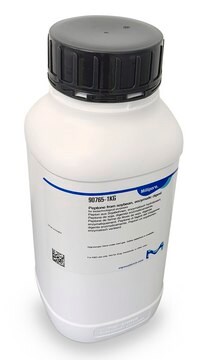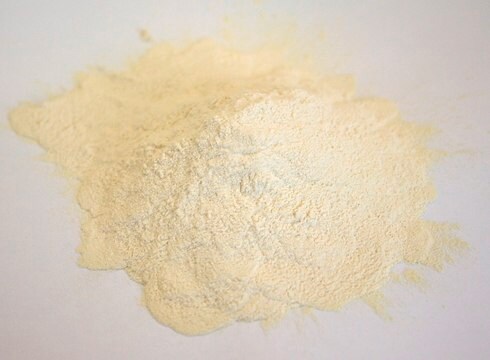おすすめの製品
製品名
ペプトン カゼイン由来, Enzymatic digest of casein, for biotechnological purposes
由来生物
bovine milk
品質水準
フォーム
powder
組成
total nitrogen (N), ~13%
窒素分析
, ~0.3 AN:TN ratio
強熱残分
<17%
損失
<6% loss on drying
pH
7.0±0.5 (2% in H2O)
溶解性
H2O: 2%, clear, yellow to tan
water: soluble 2%, clear, faintly brown-yellow
アプリケーション
food and beverages
microbiology
類似した製品をお探しですか? 訪問 製品比較ガイド
関連するカテゴリー
詳細
Peptone from an enzymatic digest of casein is used as a nitrogen source in culture media formulated for isolating and cultivating fastidious and non-fastidious bacteria and fungi. It is a refined hydrolysate with high solubility and is used as a microbiological nutrient. It is a rich source of amino acids and peptides recommended for culture media in analytical microbiology and industrial fermentation.
アプリケーション
Peptone from casein may be used as medium supplement in the following:
Bacterial cultures for short term storage of bacteria.
The basal Glucose Yeast Peptone (GYP) medium.
As nitrogen supplement in the culture medium of Ceriporiopsis subvermispora.
Culture medium of Methylobacterium rhodesianum and Ralstonia eutropha.
Bacterial cultures for short term storage of bacteria.
The basal Glucose Yeast Peptone (GYP) medium.
As nitrogen supplement in the culture medium of Ceriporiopsis subvermispora.
Culture medium of Methylobacterium rhodesianum and Ralstonia eutropha.
保管分類コード
11 - Combustible Solids
WGK
WGK 1
引火点(°F)
Not applicable
引火点(℃)
Not applicable
個人用保護具 (PPE)
Eyeshields, Gloves, type N95 (US)
適用法令
試験研究用途を考慮した関連法令を主に挙げております。化学物質以外については、一部の情報のみ提供しています。 製品を安全かつ合法的に使用することは、使用者の義務です。最新情報により修正される場合があります。WEBの反映には時間を要することがあるため、適宜SDSをご参照ください。
Jan Code
82303-1KG-F:
82303-BULK-F:
82303-10G-F-KC:
82303-VAR-F:
82303-5KG-F:
この製品を見ている人はこちらもチェック
Volatiles of bacterial antagonists inhibit mycelial growth of the plant pathogen Rhizoctonia solani.
Marco Kai et al.
Archives of microbiology, 187(5), 351-360 (2006-12-21)
Bacterial antagonists are bacteria that negatively affect the growth of other organisms. Many antagonists inhibit the growth of fungi by various mechanisms, e.g., secretion of lytic enzymes, siderophores and antibiotics. Such inhibition of fungal growth may indirectly support plant growth.
Wolfgang Harreither et al.
Applied and environmental microbiology, 75(9), 2750-2757 (2009-03-10)
Cellobiose dehydrogenase (CDH), an extracellular flavocytochrome produced by several wood-degrading fungi, was detected in cultures of the selective delignifier Ceriporiopsis subvermispora when grown on a cellulose- and yeast extract-based liquid medium. CDH amounted to up to 2.5% of total extracellular
The production of polyhydroxybutyrate by Methylobacterium rhodesianum and Ralstonia eutropha in media containing glycerol and casein hydrolysates.
Bormann EJ and Roth M.
Biotechnology Letters, 21(12), 1059-1063 (1999)
Christiane Galhaup et al.
Microbiology (Reading, England), 148(Pt 7), 2159-2169 (2002-07-09)
The major laccase isoenzyme LAP2 secreted by the white-rot basidiomycete Trametes pubescens in response to high copper concentrations was purified to apparent electrophoretic homogeneity using anion-exchange chromatography and gel filtration. The monomeric protein has a molecular mass of 65 kDa
Holly Newton et al.
Nature communications, 11(1), 4653-4653 (2020-09-18)
Cancer cells demand excess nutrients to support their proliferation, but how tumours exploit extracellular amino acids during systemic metabolic perturbations remain incompletely understood. Here, we use a Drosophila model of high-sugar diet (HSD)-enhanced tumourigenesis to uncover a systemic host-tumour metabolic
ライフサイエンス、有機合成、材料科学、クロマトグラフィー、分析など、あらゆる分野の研究に経験のあるメンバーがおります。.
製品に関するお問い合わせはこちら(テクニカルサービス)